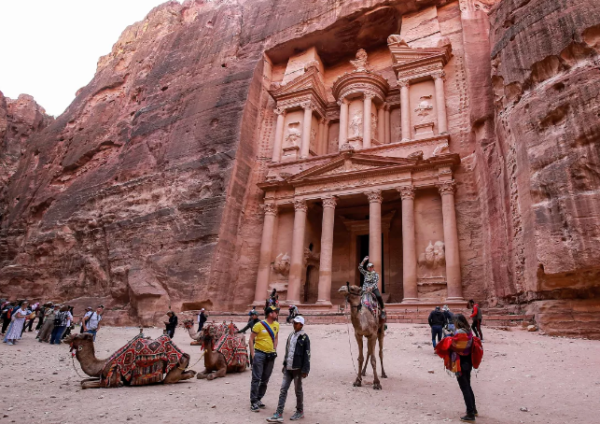By James Doubek
 Archaeologists say they’ve made a remarkable discovery in a place already known for its rich ancient history: 12 full skeletons in a tomb beneath one of Jordan’s biggest tourist attractions.
Archaeologists say they’ve made a remarkable discovery in a place already known for its rich ancient history: 12 full skeletons in a tomb beneath one of Jordan’s biggest tourist attractions.
The remains were found beneath the Treasury, also called Al Khazneh, in the ancient city of Petra — famous as a landmark seen in the movie Indiana Jones and the Last Crusade.
The Treasury, believed to be a mausoleum, was carved by the Nabataean people around 2,000 years ago. Petra was the capital of the Nabataeans, who carved many elaborate structures out of rose-colored rock. The city is now a UNESCO World Heritage site.
Richard Bates, a professor of geophysics at the University of St Andrews in Scotland who was part of the archaeological team, said the discovery will help researchers learn more about the ancient people.
“If you look at all the other tombs in the Petra area, only a few have ever contained any human remains, and those are very fragmentary, whereas this has got 12 complete bodies within it,” he told NPR.
Bates said the discovery not only sheds light on the rituals involved in Nabataean birth and death practices, but also, “by analyzing the skeleton material, the teeth, the bones, we can tell things about their lifestyle. So it’s going to unlock a view on Nabataean life that we’ve just never had access to before.”
A local archaeological team obtained the rare permission to get inside the Treasury building. Bates ran ground-penetrating radar as part of the team. “That’s when we discovered the signals which I interpreted as voids in the subsurface,” he said.
The new chamber is about 18 feet by 18 feet and 9 feet tall, he estimates, and preliminary dating puts it from around the first century B.C. to the first century A.D., in the middle of the Nabataean Kingdom. The civilization existed from roughly the 4th century B.C. until it was annexed by the Romans in 106 A.D.
Archaeologists had already discovered indications of this tomb around 2003, but the dig site was shut down over lack of funding at the time, Bates said. Separate tombs were discovered at the Treasury in 2004, according to Petra’s tourism authority, which says they were royal tombs.
The tomb’s discovery happened over the summer but is now being publicized as part of the show Expedition Unknown on the Discovery Channel.
In a coincidence, the crew also found that one skeleton was holding a ceramic vessel similar to a famous chalice seen in the Indiana Jones movie.















